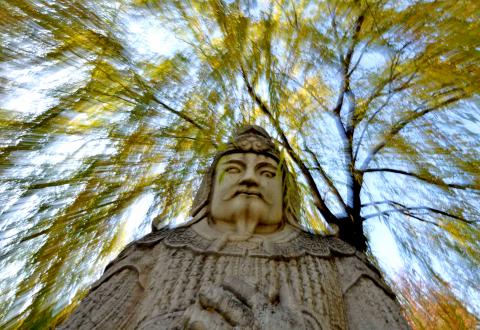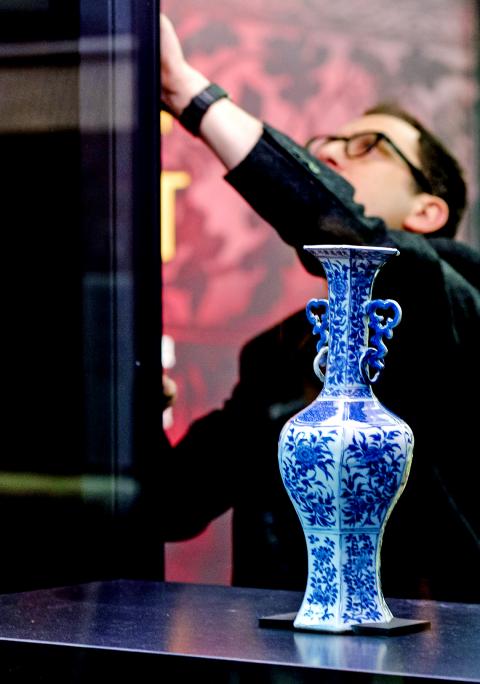The word Ming conjures up precious, fragile, beautiful things. “Man breaks priceless Ming vase” was a story to remember in 2006, even though the three Chinese vases smashed by a clumsy visitor to the Fitzwilliam Museum in Cambridge weren’t Ming at all. They were made in the Qing (or Manchu) era. So why are we so quick to reach for this word? Why are we so fixated with this one period in the long, brilliant history of China? And does this Ming mania blind us to the intelligence, ambition and originality of other ancient Chinese art?
If you want proof that we Westerners are still as in thrall to the Ming dynasty as our grandparents (mine decorated their house with fake Ming vases), consider the fact that not one but two blockbuster Ming exhibitions can be seen in Britain this year. Ming: The Golden Empire is at the National Museum of Scotland, while Ming: 50 Years that Changed China opens next week at the British Museum. There’s even a UK touring exhibit of a single Ming vase, courtesy of the British Museum, for those who can’t get to Edinburgh or London.
CLICHES

Photo: AFP
So why do we have this stereotype? Why do we think that all art made in China before modern times can be boiled down to two words: Ming vase? The Ming dynasty, which ruled from 1368 to 1644, now provides instant brand recognition: it has become shorthand for a golden age of Chinese civilization. The museums know that. From Pompeii to Vikings to Ming, if you’re going to sell history, pick a period with a sexy name. An exhibition called Song or Tang wouldn’t have nearly the same blockbusting appeal, even though both dynasties were far more artistically creative.
The Ming era was not the golden age of Chinese civilization, whatever blockbuster shows try to suggest. It was an age of missed opportunities and weak but brutal rulers, sandwiched between two periods of foreign domination. And it heralded imperial China’s decline into impotence and backwardness. It would take the 20th century, which saw a revolution and a transition from communism to capitalism, to make China great again.
The real golden age happened earlier and was contemporary with a period in European history that encompasses ancient Greece, the Roman Empire, the Dark Ages and the Middle Ages. Confucius, said to have lived from 551BC to 479BC, created a philosophy of government and ethics that was to be the backbone of Chinese civilization for more than 2,000 years. Then, as Rome conquered the west, the Qin and Han dynasties created a powerful Chinese state. There was even trade between Rome and China, via the fabled Silk Road through Afghanistan.

Photo: AFP
But the Roman Empire collapsed and Europe was plunged into poverty and barbarism. China meanwhile became more and more civilized. Despite political ups and downs, the culture of the Tang (618 to 907) and Song (960 to 1279) dynasties was brilliant. This, and not the Ming age, was when porcelain was perfected and when China invented printing, gunpowder and the compass. While those inventions are well known, the west remains blind to the artistic originality of the Tang and Song, dazzled by the myth of Ming and the notion of Chinese art as something ceramic and shiny that looks nice on the mantelpiece. We have reduced a civilization to decoration, “chinoiserie” as it was called in the 18th century.
What did happen during the Ming era was that China and Europe discovered one another — though that may not be quite the right word, for each remained largely ignorant of the other, trading without learning, dreaming without seeing. In 1498, Portuguese explorer Vasco da Gama sailed around Africa to India. Once that eastward route was established, it was only a matter of time before European navigators reached China. By 1577, Portugal had a base in Macao and soon the Dutch East India Company (DEIC) was muscling in.
BIRTH OF A CULT
Two Portuguese ships loaded with more than 200,000 Chinese porcelain objects were seized by the Dutch in 1604. After these were auctioned at the courts of Europe, the DEIC imported so much Ming-era porcelain that they appear routinely as household objects in 17th-century Dutch art. The cult of the Ming vase was born. By the 18th century, China was making porcelain to western specifications. Our reverence for porcelain of the Ming era was born and it remains a cultural cliche to this day.
So what is wrong with admiring this porcelain, which was taken to refined heights by the imperial workshops at Jingdezhen (景德鎮)? The answer lies in a fascinating exhibit in the British Museum show. It is not Chinese but Italian: the Renaissance artist Andrea Mantegna’s painting The Adoration of the Magi. In this work, from about 1500, Mantegna depicts a Ming porcelain cup as one of the gifts the wise men bring. Pictured in exquisite detail, it is one of the very first European images of Chinese porcelain. Mantegna plainly admires it. Yet it is an artefact within an artwork: something smaller inside something greater. While porcelain is beautiful, a Renaissance painting like this embodies all the reasons the west came to believe itself superior — a more ambitious, more intellectual way of seeing the world. A painting is a work of thought as well as craft. A pot, however lovely, is only a pot.
In the west’s cult of Ming porcelain, a patronizing lie is concealed. For China’s art before modern times was not just decorative. Far from it. Centuries before Mantegna was even born, painters in Song China depicted nature with acute, mind-boggling naturalism. When Europe was mired in medieval squalor, China’s artists did not simply paint landscapes with deep sensitivity - they invented the idea of art as an intellectual and meditative activity. It was scholars and even emperors who painted on silk, using brushes to reveal their emotions. Painters in China were praised for their expressive, individual manner, long before such ideas occurred to Europeans.
In other words, many of the key ideas of the Renaissance and even of modern art (naturalism, the high status of the artist, the belief that art is self-expression) were invented long before in China. That’s a truth to stand the story of art on its head. But we can’t see it for all those Ming vases on the mantelpiece.

One of the biggest sore spots in Taiwan’s historical friendship with the US came in 1979 when US president Jimmy Carter broke off formal diplomatic relations with Taiwan’s Republic of China (ROC) government so that the US could establish relations with the People’s Republic of China (PRC). Taiwan’s derecognition came purely at China’s insistence, and the US took the deal. Retired American diplomat John Tkacik, who for almost decade surrounding that schism, from 1974 to 1982, worked in embassies in Taipei and Beijing and at the Taiwan Desk in Washington DC, recently argued in the Taipei Times that “President Carter’s derecognition

JUNE 30 to JULY 6 After being routed by the Japanese in the bloody battle of Baguashan (八卦山), Hsu Hsiang (徐驤) and a handful of surviving Hakka fighters sped toward Tainan. There, he would meet with Liu Yung-fu (劉永福), leader of the Black Flag Army who had assumed control of the resisting Republic of Formosa after its president and vice-president fled to China. Hsu, who had been fighting non-stop for over two months from Taoyuan to Changhua, was reportedly injured and exhausted. As the story goes, Liu advised that Hsu take shelter in China to recover and regroup, but Hsu steadfastly

This year will go down in the history books. Taiwan faces enormous turmoil and uncertainty in the coming months. Which political parties are in a good position to handle big changes? All of the main parties are beset with challenges. Taking stock, this column examined the Taiwan People’s Party (TPP) (“Huang Kuo-chang’s choking the life out of the TPP,” May 28, page 12), the Democratic Progressive Party (DPP) (“Challenges amid choppy waters for the DPP,” June 14, page 12) and the Chinese Nationalist Party (KMT) (“KMT struggles to seize opportunities as ‘interesting times’ loom,” June 20, page 11). Times like these can

You can tell a lot about a generation from the contents of their cool box: nowadays the barbecue ice bucket is likely to be filled with hard seltzers, non-alcoholic beers and fluorescent BuzzBallz — a particular favorite among Gen Z. Two decades ago, it was WKD, Bacardi Breezers and the odd Smirnoff Ice bobbing in a puddle of melted ice. And while nostalgia may have brought back some alcopops, the new wave of ready-to-drink (RTD) options look and taste noticeably different. It is not just the drinks that have changed, but drinking habits too, driven in part by more health-conscious consumers and